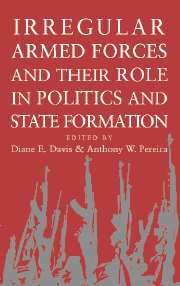Book contents
- Frontmatter
- Contents
- Contributors
- Irregular Armed Forces and Their Role in Politics and State Formation
- Introduction
- Part I The Basic Framework and Beyond
- Part II Deconstructing Armed Forces
- 6 Send a Thief to Catch a Thief
- 7 Reform and Reaction
- 8 Policing the People, Building the State
- 9 War-Making and U.S. State Formation
- 10 Politics Is Thicker Than Blood
- Part III Not Just the Nation-State
- Conclusion
- Index
6 - Send a Thief to Catch a Thief
State-Building and the Employment of Irregular Military Formations in Mid-Nineteenth-Century Greece
Published online by Cambridge University Press: 23 November 2009
- Frontmatter
- Contents
- Contributors
- Irregular Armed Forces and Their Role in Politics and State Formation
- Introduction
- Part I The Basic Framework and Beyond
- Part II Deconstructing Armed Forces
- 6 Send a Thief to Catch a Thief
- 7 Reform and Reaction
- 8 Policing the People, Building the State
- 9 War-Making and U.S. State Formation
- 10 Politics Is Thicker Than Blood
- Part III Not Just the Nation-State
- Conclusion
- Index
Summary
The relation between war and state-building is a highly intricate phenomenon. Although war is not the sole justification for the emergence and development of the modern state, it has been acknowledged as one of the most important factors (Tilly 1992: 12, 14–15; Desch 1996: 241). One analytical avenue stresses that modern states are formed as state makers attempt to find ways of acquiring the necessary resources for military competition at a geopolitical level. In return, the difficulties encountered in building and maintaining an effective military force (social resistance, expense, organization, etc.) led to the creation of the modern centralized, bureaucratic state apparatus.
The main limitation of this approach is that it fails to account for the diversity of state-building processes and variations in outcome. Accordingly, Charles Tilly (1985) maintains that the development of Western European states was characterized by the variable interaction between state-making (elimination of internal competitors), war-making (elimination of external competitors), protection (elimination of the enemies of clients), and extraction (acquisition of the necessary resources to accomplish the former three).
This multilinear analytical model of state formation is based on the ideas that state protection is a revenue-generating affair, and that the process of state-building is a legitimate form of protection racket. States “themselves simulate, stimulate, or even fabricate threats of external war” (Tilly 1985: 171) in order to justify demands on the resources of private capital and the construction of larger and more powerful state institutions.
- Type
- Chapter
- Information
- Publisher: Cambridge University PressPrint publication year: 2003
- 2
- Cited by

